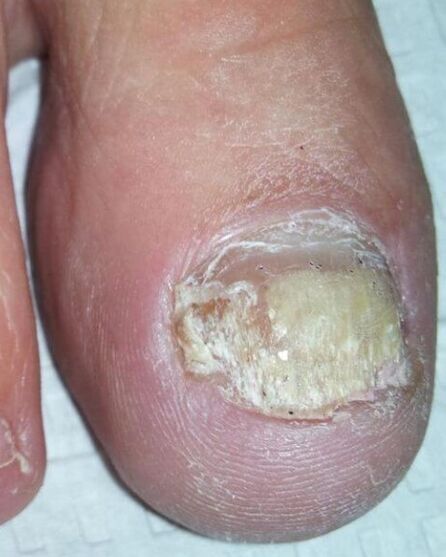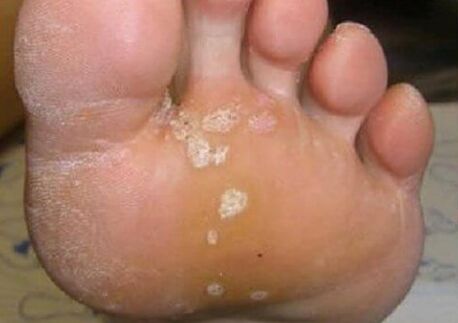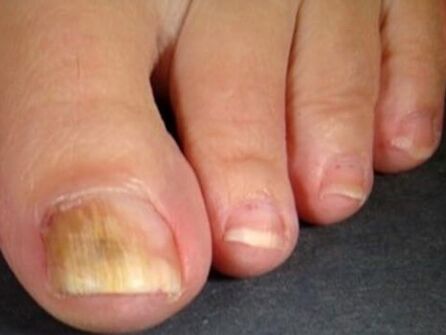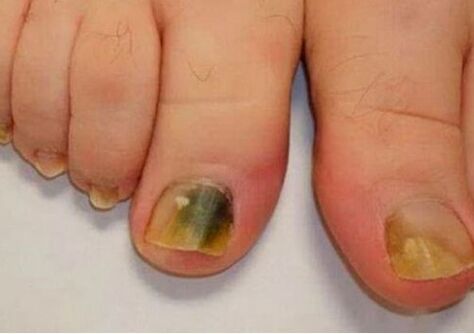Redness, peeling of the skin, the appearance of cracks between the fingers, the ulcer in the foot, the change in the condition of the nail: the loss of shining, the common pink shade, the thickening of the plate -these and other signs indicate the development of fungal infections. Every fifth population is sick with mycosis. Therefore, you need to know how the fungus looks and behaves on the feet, what causes its appearance and how to treat this unpleasant disease.

Cause
In most cases, mycosis infection comes from a person to a person directly or through the surrounding object. Encouraging conditions for fungal reproduction are fever, moisture. Disputes can also maintain the viability of dry conditions, after the poor processing of the manicure device.
The main reasons for this disease include:
- Lack of normal foot care.
- Stay with people suffering from fungus.
- Using other people's shoes, socks.
- Stop injury.
- Visit the general area of "mushrooms" (beaches, baths, pools).
- Insufficient accessory processing for pedicures.
- Wear tight shoes from synthetic materials.
- Professional damage (working in high temperature and humidity).
- Shooting shoes at a shop without socks or detachment.
Fungal diseases in humans develop faster to the background of functional features, as well as changes that lead to suppression of immunity, declining local circulation, changes in skin conditions. The reasons from the body are as follows:
- endocrine pathology (diabetes, obesity);
- pregnancy;
- the state of immunodeficiency;
- increased sweating;
- foot disease;
- vascular disorders;
- chronic skin diseases (eczema, psoriasis);
- Consumption of long drugs that suppress immunity (corticosteroids, cytostatics).
The type of pathogenic mushroom
Mushrooms in the human body eat protein - keratin, elastin, collagen, split it with enzymes: keratinase. The localization of mycosis depends on the activity of keratinase and the ability to digest various types of keratin.
Mycoses on the feet cause the following types of fungus:
- Trichophyton rubrum-a type of fungus-saprophytes inhabit a keratinized skin layer. Causes of cutting lichen, damage to the epidermis, nails in 80 % of cases.
- Trichophyton mentagraphytes causes a stop epidermophytius.
- Trichophyton Interdigitite. In the feet, the fungus causes dermatophytosis, onychomycosis.
- The genus Candida mushrooms affect the skin and nail plates with a severe decrease in immunity affecting the skin and nail plates with severe immunity.
Fungal skin lesions

From mycosis in the feet, skin wounds during psoriasis (sometimes it is called dry fungus) - a red plaque with peeling and tendency for the merger to rise above the surface. Such elements are often found in the knees, feet. The disease is not associated with fungal infections.
The manifestation of the foot fungus is divided into four main forms. The convention is a combination of clinical signs and the possibility of transition from one to another.
In intertriginous form, the skin is experienced in the interdigital space. The skin fungus shows itself in the form of itching, burning, it is accompanied by an unpleasant odor. Often infections affect the feet from intervals between 3 and 4, 4 and 5 fingers. The skin becomes red, soaked with moisture, wounds, crying areas appear between the fingers. These signs develop freely or oppose the background of the existing squamous form.
Note! For typical intertriginous lesions, attachment of secondary bacterial infections that worsen the disease. Bacteria, micotic eczema develops with the formation of rash not only in the feet, the elements of inflammation appear in the ankle, lowering.
The more advanced squamous-hyperkeratic forms look like a normal corn, large in the only crack. Initially, mycosis of the skin can draw attention to dryness, peel off the skin, limited corn of the heel. People consider such symptoms of individual characteristics and do not turn to dermatologists. Skin lesions can accompany itchy, burn. If you look at the pictures of the fungus on the foot with this form of mycosis, you can see a deep fracture against the thickening background (and, as in the moccasin) of the skin. Such manifestations are painful. Squamous forms are characterized by the involvement of nail plate with their destruction, lagging behind the nail bed.
Manifestations of dyshidrotic forms (vesicular) foot fungus. The main symptoms of the disease are the formation of bubbles with thick skin and transparent content. They are localized on the single side of the feet, fingers as a single formation or drain. Then the bubble is opened with the formation of erosion with a puruled crust around the edge. Vesicular lesions complications include:
- Toxic reactions. They grow for 4-6 days, often localized to symmetrically: swollen redness papules can be found in the feet, lower legs, lower arm, face, mucous membranes.
- Connection of bacterial infections or secondary viruses with eczema development.

The shape of the fungus on the feet is characterized by a minimal lesion, so it is not easy to recognize it. The main signs: the appearance of the intestine, the formation of the microccrow between the fingers, the discomfort, the burning. With long courses, the nail plate is involved.
Nail fungus
Onychomycosis appears as the result of skin fungus on the fingers, feet, without the attention of adequate problems and treatment.
The first symptoms and signs of onychomycosis can also be provided. You should contact the nail fungus on the feet and contact the dermatologist at:
- Change of nail plate color;
- the appearance of yellow or gray spots;
- loss of shining;
- appearance on the surface of the deviation;
- strips in the nail structure;
- Increased disadvantages.
There are various classifications of onychomycosis. With the appearance of nail plates, they are divided into:
- Normotrophic. Fungal infections change the color of the nail to the yellowish gray, the thickness and the shape remain the same.
- Hypertrophic. This type of fungus is characterized by a rough change: the nails turn yellow, thickened. If you look at the pictures that describe this type of onychomycosis, you can see the features of the plate shape. Horizontal, loosening and tenderness on free edge can be seen. Changes in the nails lead to their growth. Walking into pain.
- Onycholithic. The nail plate becomes thinner, changed color, peel off the nail bed.
According to localization and degree of damage to the nail plate, the following types of onychomycosis are distinguished: distal; side; mixed, proximal; Amount; surface.
Defeat of candidiasis
Separately, damage to the genus Candida mushrooms should be considered. These pathogenic mushrooms cause deep (affecting the internal organs) and surface mycoses (dermatomycosis, onychomycosis). Under normal circumstances, human immunity suppresses this fungal reproduction and large infections -the non -occurrence occurs. Therefore, Candida activity is indicated by significant disorders in the body and requires a thorough examination to establish the cause of immunodeficiency. The first signs of infection are difficult to distinguish from injury, inflammation.

Fungal damage to the feet develops as follows:
- On the toes there is inflammation of the nail roller with redness, swelling, cracks on the skin, appearance of discomfort in any movement. Under the nail plate, the white -separated white shade is formed.
- Changes in inflammation in the skin, the disease becomes chronic. The skin around the nails thickens, stops growing. This infection affects the nail plate.
- The nails on the feet begin to thicken, to sprinkle. Their colors are brown, brown. Violation of blood supply leads to rejection.
Diagnostics
The diagnosis of fungus on the feet includes:
- Conversations with patients (complaints, accompanying illnesses, working conditions, possible explanations of infection).
- Inspection.
- Methods of laboratory research (skin scraping, nails with microscopy, sowing specific plants by determining the sensitivity of medicines, Ig G to Aspergille, candidates).
Treatment
Fungus on the feet requires immediate treatment that a dermatologist (or mycologist) will be prescribed. You can perform tasks on outpatients.
How and how to treat fungus on the feet depends on several conditions:
- Localization of pathological processes;
- degree, severity of defeat;
- presence of equivalent disease;
- patient age;
- In the case of female therapy - the fact of pregnancy, breastfeeding.
Fungal treatment on the feet takes a lot of time and its main goal is to lose the signs of clinical and laboratory infections. Incomplete therapy courses lead to relapse of the disease.
Drug therapy
Drug treatment is carried out using antifungal drugs that not only destroy mycosis, but also help eliminate manifestations of inflammation and eliminate secondary infections.
They are divided into:
- Local. Apply to lesions (ointment, gel, cream, spray, varnish, solution).
- Systemic - take orally (tablets, capsules, solutions).
In the early stages of fungal infection, drug therapy is limited to local funds appointments. With the same mycosis, with severe courses, systemic antimicrotic connections are required.
Treatment with folk medicine.
There are many suggestions on how to get rid of fungus in the people's feet and home remedies. Most imply external use, and some - inside. However, you cannot drink and apply a dubious composition to your feet in the hope of bringing a neglected mycosis. Such people's methods can damage health.

Note! The most common and effective home remedies for fungus are the feet for salt, soda, essential oils. This therapeutic procedure provides feet and nails for drug use.
Surgical
With large fungal damage, the nail plate should be removed. This method is safe and practical with no contraindications. Alternatives to surgical manipulation - the use of pasta and ointment to soften the nails followed by removal.
Laser treatment
The use of lasers to combat onychomycosis is based on heating and destroys fungal spores with directed beams. This technique allows you to cure onychomycosis quickly, safely and can be used in patients who are contraindicated in systemic treatment.
Dermatomicosis treatment
To start fungal treatment, local antifungal agents are used on the feet. If after 2 weeks of treatment there is no improvement in this condition, an antimicrotic agent is required. In the event of severe damage, skin fungus requires a systemic prescription. Therapy persists until complete removal of infection.
Onychomycosis treatment
To eliminate early manifestations of nail fungus, local medicines are prescribed. Mycosis with wounds more than 2/3 of the nail area, which involves growth zones, distribution to other plates - indicators for taking systemic drugs. Onychomycosis with large destruction of the nail plate began to be treated with nail -affected tissue surgery. This method provides access to the focus of the infection.
IMPORTANT!
Onychomycosis treatment is performed before growing healthy nails and can last up to 12 months.
The appearance of fungus in the feet can be caused by a variety of reasons. The attention of your health will help to recognize the disease over time and start treatment.



























